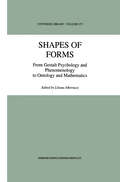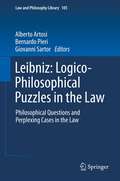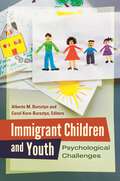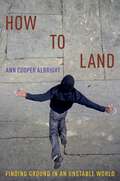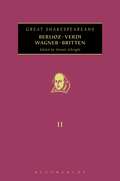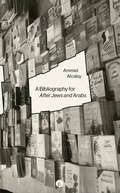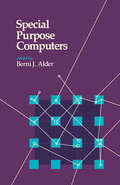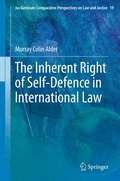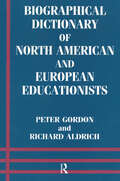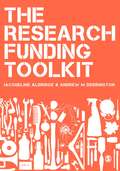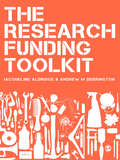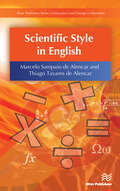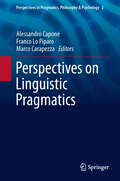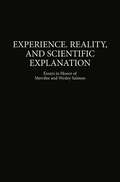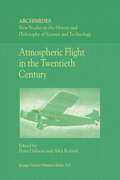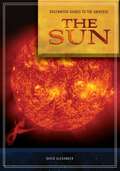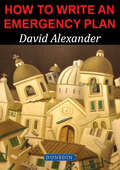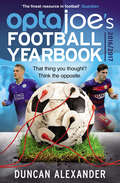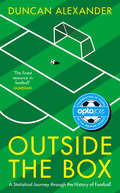- Table View
- List View
Shapes of Forms: From Gestalt Psychology and Phenomenology to Ontology and Mathematics (Synthese Library #275)
by Liliana Albertazziimpossible triangle, after apprehension of the perceptively given mode of being of that 'object', the visual system assumes that all three sides touch on all three sides, whereas this happens on only one side. In fact, the sides touch only optically, because they are separate in depth. In Meinong's words, Penrose's triangle has been inserted in an 'objective', or in what we would today call a "cognitive schema". Re-examination of the Graz school's theory, as said, sheds light on several problems concerning the theory of perception, and, as Luccio points out in his contribution to this book, it helps to eliminate a number of over-simplistic commonplaces, such as the identification of the cognitivist notion of 'top down' with Wertheimer's 'von oben unten', and of 'bottom up' with his 'von unten nach oben'. In fact, neither Hochberg's and Gregory's 'concept-driven' perception nor Gibson's 'data-driven' perception coincide with the original conception of the Gestalt.
Cognitive Aspects of Bilingualism
by Liliana Albertazzi Istvan KecskesThis work has a uniquely cognitive-functional perspective on bi-lingualism. This means that it makes a clear distinction between real world and projected world. Information conveyed by language must be about the projected world. Both the experimental results and the systematic claims in this volume call for a weak form of whorfianism. The authors examine too some relatively unexplored issues of bilingualism, such as, among others, gender systems in the bilingual mind, synergic concepts, and ontological categorization.
Leibniz: Philosophical Questions and Perplexing Cases in the Law (Law and Philosophy Library #105)
by Alberto Artosi, Bernardo Pieri and Giovanni SartorThis volume presents two Leibnizian writings, the Specimen of Philosophical Questions Collected from the Law and the Dissertation on Perplexing Cases. These works, originally published in 1664 and 1666, constitute, respectively, Leibniz’s thesis for the title of Master of Philosophy and his doctoral dissertation in law. Besides providing evidence of the earliest development of Leibniz’s thought and amazing anticipations of his mature views, they present a genuine intellectual interest, for the freshness and originality of Leibniz’s reflections on a striking variety of logico-philosophical puzzles drawn from the law. The Specimen addresses puzzling issues resulting from apparent conflicts between law and philosophy (the latter broadly understood as comprising also mathematics, as well as empirical sciences). The Dissertation addresses cases whose solution is puzzling because of the convoluted logical form of legal dispositions and contractual clauses, or because of conflicting priorities between concurring parties. In each case, Leibniz dissects the problems with the greatest ingenuity, disentangling their different aspects, and proposing solutions always reasonable and sometimes surprising. And he does not refrain from peppering his intellectual acrobatics with some humorous comments.
Immigrant Children and Youth: Psychological Challenges
by Alberto M. Bursztyn and Carol Korn-Bursztyn, EditorsImmigrants now comprise one-fourth of the 75 million children in the United States. The ability of today's immigrant children to become productively engaged adults hinges on their internal resources and mental health. This book ascertains their psychological challenges and their often misunderstood needs.This book is intended to inform both the general public and professionals working with immigrant children and adolescents about the importance and complexity of addressing their psychological issues and experiential challenges. The work covers the topic of immigrant children's mental health from multiple perspectives while maintaining a focus on developmental needs and identifying the specific problems posed by linguistic and cultural transition.The chapters present case studies and vignettes that serve to illustrate the topics, providing vivid depictions of mental health issues and highlighting the importance of specific interventions. As new immigrant groups continue to settle in the United States, the social and emotional well-being of their children has far-reaching implications for the future of our society, making this volume of critical significance to therapists, educators, policymakers, child advocates, and other audiences.
How to Land: Finding Ground in an Unstable World
by Ann Cooper AlbrightHow to Land: Finding Ground in an Unstable World foregrounds the importance of embodiment as a means of surviving the disorientation of our twenty-first century world. Linking somatics and politics, author Ann Cooper Albright argues that a renewed attention to gravity as both a metaphoric sensibility and a physical experience can help transform moments of personal disorientation into an opportunity to reflect on the important relationship between individual resiliency and communal responsibility. Long one of the nation's preeminent thinkers in dance studies, Albright asks how contemporary bodies are affected by repeated images of falling bodies, bombed-out buildings, and displaced peoples, as well as recurring evocations of global economies and governments in discursive free fall or dissolution. What kind of fear gets lodged in connective tissue when there is an underlying anxiety that certain aspects of our world are in danger of falling apart? To answer this question, she draws on analyses of perception from cognitive studies, tracing the discussions of meaning, body and language through the work of Sara Ahmed, Jean-Luc Nancy, and Shaun Gallagher, among others. In addition, she follows the past decade of debate in contemporary media concerning the implications of the weightless and two-dimensional social media exchanges on structures of attention and learning, as well as their effect on the personal growth and socialization of a generation of young adults. Each chapter interweaves discussions of movement actions with their cultural implications, documenting specific bodily experiences and then tracing their ideological ripples out through the world.
HOW TO LAND C: Finding Ground in an Unstable World
by Ann Cooper AlbrightHow to Land: Finding Ground in an Unstable World foregrounds the importance of embodiment as a means of surviving the disorientation of our twenty-first century world. Linking somatics and politics, author Ann Cooper Albright argues that a renewed attention to gravity as both a metaphoric sensibility and a physical experience can help transform moments of personal disorientation into an opportunity to reflect on the important relationship between individual resiliency and communal responsibility. Long one of the nation's preeminent thinkers in dance studies, Albright asks how contemporary bodies are affected by repeated images of falling bodies, bombed-out buildings, and displaced peoples, as well as recurring evocations of global economies and governments in discursive free fall or dissolution. What kind of fear gets lodged in connective tissue when there is an underlying anxiety that certain aspects of our world are in danger of falling apart? To answer this question, she draws on analyses of perception from cognitive studies, tracing the discussions of meaning, body and language through the work of Sara Ahmed, Jean-Luc Nancy, and Shaun Gallagher, among others. In addition, she follows the past decade of debate in contemporary media concerning the implications of the weightless and two-dimensional social media exchanges on structures of attention and learning, as well as their effect on the personal growth and socialization of a generation of young adults. Each chapter interweaves discussions of movement actions with their cultural implications, documenting specific bodily experiences and then tracing their ideological ripples out through the world.
Berlioz, Verdi, Wagner, Britten: Great Shakespeareans: Volume XI (Great Shakespeareans)
by Daniel AlbrightGreat Shakespeareans offers a systematic account of those figures who have had the greatest influence on the interpretation, understanding and cultural reception of Shakespeare, both nationally and internationally. In this volume, leading scholars assess the contribution of Berlioz, Verdi, Wagner and Britten to the afterlife and reception of Shakespeare and his plays. Each substantial contribution assesses the double impact of Shakespeare on the figure covered and of the figure on the understanding, interpretation and appreciation of Shakespeare, provide a sketch of their subject's intellectual and professional biography and an account of the wider cultural context, including comparison with other figures or works within the same field.
Berlioz, Verdi, Wagner, Britten: Great Shakespeareans: Volume XI (Great Shakespeareans)
by Daniel AlbrightGreat Shakespeareans offers a systematic account of those figures who have had the greatest influence on the interpretation, understanding and cultural reception of Shakespeare, both nationally and internationally. In this volume, leading scholars assess the contribution of Berlioz, Verdi, Wagner and Britten to the afterlife and reception of Shakespeare and his plays. Each substantial contribution assesses the double impact of Shakespeare on the figure covered and of the figure on the understanding, interpretation and appreciation of Shakespeare, provide a sketch of their subject's intellectual and professional biography and an account of the wider cultural context, including comparison with other figures or works within the same field.
A Bibliography for After Jews and Arabs
by Ammiel AlcalayAmmiel Alcalay’s groundbreaking work, After Jews and Arabs, published in 1993, redrew the geographic, political, cultural, and emotional map of relations between Jews and Arabs in the Levantine/Mediterranean world over a thousand-year period. Based on over a decade of research and fieldwork in many disciplines—including history and historiography; anthropology, ethnography, and ethnomusicology; political economy and geography; linguistics; philosophy; and the history of science and technology—the book presented a radically different perspective than that presented by received opinion. Given the radical and iconoclastic nature of Alcalay’s perspective, After Jews and Arabs met great resistance in attempts to publish it. Though completed and already circulating in 1989, it didn’t appear until 1993. In addition, when the book was published, there wasn’t enough space to include its original bibliography, a foundational part of the project. A Bibliography for After Jews and Arabs presents the original bibliography, as completed in 1992, without changes, as a glimpse into the historical record of a unique scholarly, political, poetic, and cultural journey. The bibliography itself had roots in research begun in the late 1970s and demonstrates a very wide arc. In addition to the bibliography, we include two accompanying texts here. In “Behind the Scenes: Before After Jews and Arabs,” Alcalay takes us behind the closed doors of the academic process, reprinting the original readers reports and his detailed rebuttals, and in “On a Bibliography for After Jews and Arabs,” Alcalay contextualizes his own path to the work he undertook, in methodological, historical, and political terms.
Special Purpose Computers
by Berni J. AlderSpecial Purpose Computers describes special-purpose computers and compares them to general-purpose computers in terms of speed and cost. Examples of computers that were designed for the efficient solution of long established algorithms are given, including Navier-Stokes hydrodynamic solvers, classical molecular dynamic machines, and Ising model computers.Comprised of seven chapters, this volume begins by documenting the progress of the CalTech Concurrent Computation Program and its evolution from computational high-energy physics to a supercomputer initiative, with emphasis on the lessons learned including computer architecture issues and the trade-offs between in-house and commercial development. The reader is then introduced to the QCD Machine, a special-purpose parallel supercomputer that was designed and built to solve the lattice quantum chromodynamics problem. Subsequent chapters focus on the Geometry-Defining Processors and their application to the solution of partial differential equations; the Navier-Stokes computer; parallel processing using the Loosely Coupled Array of Processors (LCAP) system; and the Delft Ising system processor. The design and implementation of the Delft molecular-dynamics processor are also described.This book will be of interest to computer engineers and designers.
The Inherent Right of Self-Defence in International Law (Ius Gentium: Comparative Perspectives on Law and Justice #19)
by Murray Colin AlderDetermining the earliest point in time at which international law authorises a state to exercise its inherent right of self-defence is an issue which has been debated, but unsatisfactorily reasoned, by scholars and states since the 1960’s. Yet it remains arguably the most pressing question of law that faces the international community. This book unravels the legal and factual complications which have obscured the answer to this question. In contrast to most other works, it takes an historic approach by tracing the evolution of the rights, rules and principles of international law which have governed the use of force by states since the 16th century. Its emphasis on self-defence provides the reader with a new and complete understanding of how and why the international legal framework limits defensive force to repelling an imminent threat or use of offensive force which is directed at the territory of a state. Taking an historic approach enables this book to resurrect an understanding of the human defensive instinct which has guided the formation of the international law of self-defence. It also explains the true legal nature and scope of the inherent right of self-defence, of anticipatory self-defence and provides a definition of the legal commencement of an armed attack for the purpose of Article 51 of the Charter. Finally, the reader will receive a unique source of research materials and analysis of state practice and of scholarly works concerning self-defence and the use of force since the 16th century, which is suitable for all readers of international law around the world.
Biographical Dictionary of North American and European Educationists
by Richard Aldrich Peter GordonThis is a guide to the lives and work of more than 500 Americans, Canadians and Europeans in the categories subsumed under the term "educationists". Entries are almost entirely restricted to those with main careers in the 19th and 20th centuries; none of the subjects is still living.
Biographical Dictionary of North American and European Educationists
by Richard Aldrich Peter GordonThis is a guide to the lives and work of more than 500 Americans, Canadians and Europeans in the categories subsumed under the term "educationists". Entries are almost entirely restricted to those with main careers in the 19th and 20th centuries; none of the subjects is still living.
The Research Funding Toolkit: How to Plan and Write Successful Grant Applications (PDF)
by Jacqueline Aldridge Professor Andrew M DerringtonWriting high quality grant applications is easier when you know how research funding agencies work and how your proposal is treated in the decision-making process. The Research Funding Toolkit provides this knowledge and teaches you the necessary skills to write high quality grant applications. A complex set of factors determine whether research projects win grants. This handbook helps you understand these factors and then face and overcome your personal barriers to research grant success. The guidance also extends to real-world challenges of grant-writing, such as obtaining the right feedback, dealing effectively with your employer and partner institutions, and making multiple applications efficiently. There are many sources that will tell you what a fundable research grant application looks like. Very few help you learn the skills you need to write one. The Toolkit fills this gap with detailed advice on creating and testing applications that are readable, understandable and convincing.
The Research Funding Toolkit: How to Plan and Write Successful Grant Applications
by Jacqueline Aldridge Professor Andrew M DerringtonWriting high quality grant applications is easier when you know how research funding agencies work and how your proposal is treated in the decision-making process. The Research Funding Toolkit provides this knowledge and teaches you the necessary skills to write high quality grant applications. A complex set of factors determine whether research projects win grants. This handbook helps you understand these factors and then face and overcome your personal barriers to research grant success. The guidance also extends to real-world challenges of grant-writing, such as obtaining the right feedback, dealing effectively with your employer and partner institutions, and making multiple applications efficiently. There are many sources that will tell you what a fundable research grant application looks like. Very few help you learn the skills you need to write one. The Toolkit fills this gap with detailed advice on creating and testing applications that are readable, understandable and convincing.
Pearson BTEC National Health and Social Care Student Book 2 (PDF)
by Carolyn Aldworth Elizabeth Haworth Sue Hocking Peter Lawrence Nicola Matthews Marjorie Snaith Mary WhitehouseOur Health and Social Care Student Books include a wide range of units. Student Book 1, which is available to purchase separately, covers all mandatory units for the Certificate, Extended Certificate and Foundation Diploma plus a range of optional units. Student Book 2 covers 3 additional mandatory units for the Diploma and Extended Diploma qualifications and further optional units. This book will enable you to: - understand the benefits of getting involved in work experience in Health and Social Care and develop your knowledge and skills in realistic contexts - learn about the principles of safe working practices in this sector and how to respond appropriately to emergency situations - learn and apply the knowledge you need to progress – whether to the world of work or further study.
Scientific Style in English
by Marcelo Sampaio Alencar Thiago Tavares AlencarStyle is a distinctive manner of expression, in writing or speech. The wordevolved from Latin stilus, an instrument for writing, marking, or incising,such as something used by the ancients in writing on clay or waxed tablets.It is the way in which something is said or done, as distinguished fromits substance. Style is also a convention with respect to spelling, punctuation,capitalization, and typographic arrangement and display followed in writingor printing.Scientific Style in English aims to help students with the reading and writing of scientific and technical texts in English, with a particular focus on style, grammar and math. It can be used by students and professionals with basic or intermediate understanding of theEnglish language.Technical topics discussed in the book include: Scientific Style in English Mathematical Style in English Technical Style Stylistic Problems in English How to write Theses and Dissertations
Scientific Style in English
by Marcelo Sampaio Alencar Thiago Tavares AlencarStyle is a distinctive manner of expression, in writing or speech. The wordevolved from Latin stilus, an instrument for writing, marking, or incising,such as something used by the ancients in writing on clay or waxed tablets.It is the way in which something is said or done, as distinguished fromits substance. Style is also a convention with respect to spelling, punctuation,capitalization, and typographic arrangement and display followed in writingor printing.Scientific Style in English aims to help students with the reading and writing of scientific and technical texts in English, with a particular focus on style, grammar and math. It can be used by students and professionals with basic or intermediate understanding of theEnglish language.Technical topics discussed in the book include: Scientific Style in English Mathematical Style in English Technical Style Stylistic Problems in English How to write Theses and Dissertations
Perspectives on Linguistic Pragmatics (Perspectives in Pragmatics, Philosophy & Psychology #2)
by Alessandro Capone, Franco Lo Piparo and Marco CarapezzaThis volume provides insight into linguistic pragmatics from the perspective of linguists who have been influenced by philosophy. Theory of Mind and perspectives on point of view are presented along with other topics including: semantics vs. semiotics, clinical pragmatics, explicatures, cancellability of explicatures, interactive language use, reference, common ground, presupposition, definiteness, logophoricity and point of view in connection with pragmatic inference, pragmemes and language games, pragmatics and artificial languages, the mechanism of the form/content correlation from a pragmatic point of view, amongst other issues relating to language use. Relevance Theory is introduced as an important framework, allowing readers to familiarize themselves with technical details and linguistic terminology.This book follows on from the first volume: both contain the work of world renowned experts who discuss theories relevant to pragmatics. Here, the relationship between semantics and pragmatics is explored: conversational explicatures are a way to bridge the gap in semantics between underdetermined logical forms and full propositional content. These volumes are written in an accessible way and work well both as a stimulus to further research and as a guide to less experienced researchers and students who would like to know more about this vast, complex, and difficult field of inquiry.
Experience, Reality, and Scientific Explanation: Workshop in Honour of Merrilee and Wesley Salmon (The Western Ontario Series in Philosophy of Science #61)
by AlessandroPagnini Maria CarlaGalavottiThe papers collected here comprise the proceedings of a Workshop in honor ofMerrilee and Wes Salmon, held in Florence on May 17-18, 1996. The aim of the meeting was to pay homage to these two American scholars, whose contact with Italian and European Universities and Institutes had a major influence on "Continental" thought in the field of epistemology and probability. In fact, Merrilee and Wes spent various periods lecturing at the Universities of Bologna, Florence, Rome, Trieste, Catania and Pisa, as well as in the University of Constance, where they helped to build a strong cultural "bridge" with the Pittsburgh Center for the Philosophy of Science. The Florence Center for the History and Philosophy of Science is particularly thankful to the Salmons for their ongoing cooperation and frequent visits. We must not forget that Wes Salmon was in the Florence Center and at the Philosophy Department of Florence, as visiting scholar, on many occasions, and that he made important contributions which have later appeared in Italian journals, such as Iride and Rivista di jilosojia. Merrilee was a speaker at the Conference on "Genetics, Linguistics, and Archaeology" (May 20-24,1991), organized by the Florence Center. Both Wes and Merrilee often enlivened the arguments of the initiatives they took part in.
Atmospheric Flight in the Twentieth Century (Archimedes #3)
by Alex Roland, Peter GalisonAll technologies differ from one another. They are as varied as humanity's interaction with the physical world. Even people attempting to do the same thing produce multiple technologies. For example, John H. White discovered more than l 1000 patents in the 19th century for locomotive smokestacks. Yet all technologies are processes by which humans seek to control their physical environment and bend nature to their purposes. All technologies are alike. The tension between likeness and difference runs through this collection of papers. All focus on atmospheric flight, a twentieth-century phenomenon. But they approach the topic from different disciplinary perspectives. They ask disparate questions. And they work from distinct agendas. Collectively they help to explain what is different about aviation - how it differs from other technologies and how flight itself has varied from one time and place to another. The importance of this topic is manifest. Flight is one of the defining technologies of the twentieth century. Jay David Bolter argues in Turing's Man that certain technologies in certain ages have had the power not only to transform society but also to shape the way in which people understand their relationship with the physical world. "A defining technology," says Bolter, "resembles a magnifying glass, which collects and focuses seemingly disparate ideas in a culture into one bright, sometimes piercing ray." 2 Flight has done that for the twentieth century.
Guide to the Universe: The Sun (Greenwood Guides to the Universe)
by David AlexanderOur knowledge of the universe has increased tremendously over the last century, and our discoveries are not over - there remain scientific mysteries that the next generation of astronomers and planetary scientists will need to solve. This volume in the Greenwood Guides to the Universe series covers the Sun, and provides readers with the most up-to-date understanding of the current state of scientific knowledge. Scientifically sound, but written with the student in mind, The Sun is an excellent first step for researching the exciting scientific discoveries of the star at the center of our solar system.The Sun discusses all areas of research surrounding the subject, including: Sunspots and the solar surface; the many faces of the solar atmosphere; the solar wind and solar storms; and the long-term climate effects on the earth's atmosphere. The volume includes a glossary and a bibliography of useful resources for learning more about the subject.
How to Write an Emergency Plan
by David E. AlexanderThe world is becoming more hazardous as natural and social processes combine to create complex situations of increased vulnerability and risk. There is increasing recognition that this trend is creating exigencies that must be dealt with. The common approach is to delegate the task of preparing an emergency plan to someone. Often that person is expected to get on with job but rarely is the means and instruction of how to write such a plan provided to them. There are a host of instances in which the letter of the law, not the spirit, is honoured by providing a token plan of little validity.David Alexander provides, in this book, the assistance needed to write an emergency plan. It is a practical ‘how to’ manual and guide aimed at managers in business, civil protection officers, civil security officials, civil defence commanders, neighbourhood leaders and disaster managers who have been tasked with writing, reviewing or preparing emergency plans for all kinds of emergency, disaster or catastrophe. He takes the reader through the process of writing an emergency plan, step by step, starting with the rationale and context, before moving on through the stages of writing and activating a basic, generic emergency plan and concludes with information on specific kinds of plan, for example, for hospitals and cultural heritage sites.This practical guide also provides a core for postgraduate training in emergency management and has been written in such a way that it is not tied to the legal constraints of any particular jurisdiction.
OptaJoe's Football Yearbook 2016: That thing you thought? Think the opposite.
by Duncan AlexanderKane or Vardy?Pep or José? Pulis or … anybody else? Football is a game of opinions. A world where received wisdom and the law of the hunch reign supreme. But football is becoming more intelligent. The history books may say that Leicester City winning the premier league ‘defied logic’, but if you looked more closely, they were always going to win . . . From distances run to pass success rate, shots on target to corners won, counter-attacks to tackles made, Opta, the world’s leading sports data company, records everything. But what does it all mean? And how can it add to our love of the game? From the author and statistician behind the popular OptaJoe Twitter account, what follows is a hugely entertaining and insightful guide to football in 2016, analysing data from the world's greatest teams, players, leagues and tournaments. Stats can never tell us everything, but combining cutting-edge analysis with wry humour, this book debunks countless myths peddled by pundits, managers, and even players. The ideas that follow are both surprising and satisfying, but may also leave you with the feeling that ‘yes, that’s what I was thinking all along’.
Outside the Box: A Statistical Journey through the History of Football
by Duncan AlexanderIn football, numbers are everywhere. From touches in the opposition box to expected goals, clear-cut chances to win-loss ratios. In the modern game, these numbers help provide the narrative, the drama, and the conversation. They are scrutinised in order to justify results and to predict future outcomes. They even dictate transfer policy and drive clubs to achieve the impossible.But when did the numbers become so important and what do they mean?In Outside the Box, Duncan Alexander looks back at twenty-five years of the Premier League and beyond, uncovering the hidden truths and accepted myths that surround the game. Using the archives of OptaJoe and never-before-seen data, we discover why Liverpool have gone 27 years without winning a league title and why Lionel Messi is the best player in the game’s history. Or is he? Insightful, wry, and hugely entertaining, Outside the Box is an enlightening and accessible account of football across the decades, analysing data from the some of the greatest seasons, players, teams and managers.
